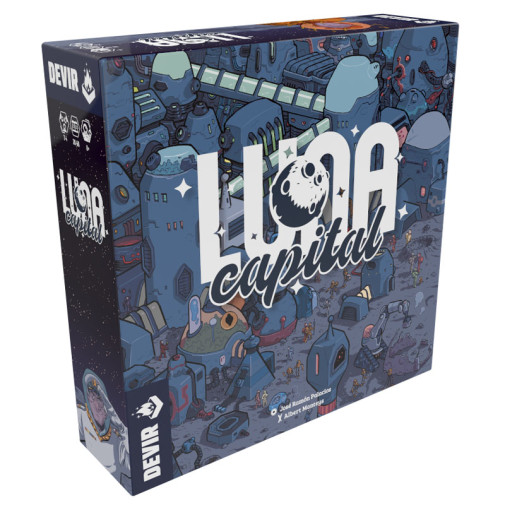We use cookies to make your experience better. To comply with the new e-Privacy directive, we need to ask for your consent to set the cookies. Learn more.
Luna Capital Game
When you colonize the moon, you will need several types of structures to support life there. There will be vital systems (hydrogen and oxygen collectors, as well as water condensers and greenhouses). There will be construction sites for residences, as well as habitation modules for the construction crews. Sales offices to help encourage people to colonize the moon are built and demolition teams are available to scrap building sites that do not fit with new plans. In Luna Capital, players will each build out a moon colony with specific scoring goals that contribute towards maximizing points. As players draw building cards and tiles each turn, their choices will be limited by the available resources each round, so good planning and strategy help as well as the ability to quickly shift goals when the resources you had planned to use do not become available on your turn. The game ends after three rounds of four turns per player and the player with the most points over a set of seven goal criteria wins the game. Because there are such varied scoring options, players may use many strategies to help bring a win to their colony. Once you learn how the symbols on the building tiles relate and which tile placement strategies will be optimum to earn points, you will be well on your way to enjoying the potential that this fun and unique game brings to your board game experience. For 2-4 players, with a 30 to 60- minute playtime based on player count.
Welcome to the moon! It's the late 70's of the 20th century, and life off Earth is no longer the stuff of science fiction. Help your sponsoring company and design the best settlement for your Selenite city to achieve the distinction of LUNA Capital.
The dream of sustaining human life on the moon is now a reality. The project to build cities on the Earth's satellite is moving at full speed, because the possibilities are enormous, and 1977 is the year in which all this is going to become a reality. The most enterprising companies have thrown themselves into sponsoring teams of scientists, builders, advertisers and nightlife professionals to build them the best customer base in the galaxy. In addition, the newly formed Lunar Sanctioning Body will award satellite capital status to the best of the projects submitted, so the reward is doubly juicy!
LUNA Capital is a game by José Ramón Palacios (La Viña), an already consolidated author who with his second title proposes a very interesting experience both for experienced players and for those who are just starting out in the world of modern board games. In the artistic section we count once again with the work and the good work of Albert Monteys (Castellers, Dungeon Raiders). Monteys, apart from being a seasoned gamer, is an internationally renowned comic book artist. All those who enjoy his work in this game should not miss his comic Universe (Astiberri), with which they will find inevitable points of contact.
In LUNA Capital, players will have to optimize the elements proposed by the game to build the best possible lunar settlement, and make it worthy of becoming the capital of the entire colony. They will have a series of building plan cards in a common "market", and each of them will be linked to a number of project tiles. Players will take one of the cards and the accompanying tiles on their turn, and arrange them in their personal playing area. The cards must be arranged in a maximum of three rows, and must always be placed respecting their ascending numerical value. Once the card has been placed, the tiles will be placed in the spaces provided on the cards, trying to group the projects as efficiently as possible.
The tiles show the available projects, indispensable to build a city in conditions. Such as oxygen collectors, greenhouses, residential complexes and (very important) sales offices to sell the apartments with the best views in the galaxy. Each of these categories will score according to their arrangement in each player's personal area, and whoever manages to get the most out of them will win the mayor's office of LUNA Capital.
| Product Format: | Other |
|---|---|
| Brand: | Devir Games |
| Grades: | 3-AD |
| EAN/UPC: | 8436589623484 |
| Length in Inches: | 9 |
| Width in Inches: | 9 |
| Height in Inches: | 2.625 |
| Weight in Pounds: | 3.4 |

